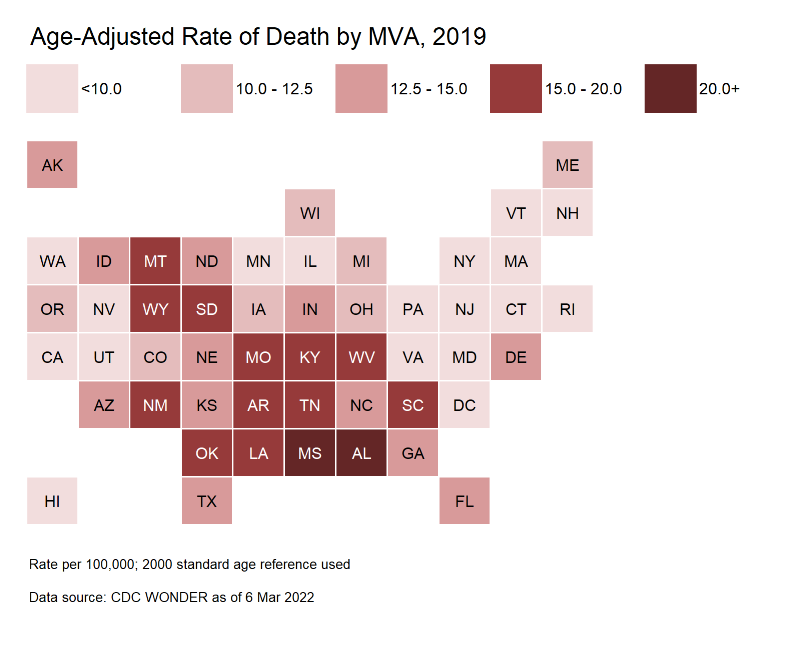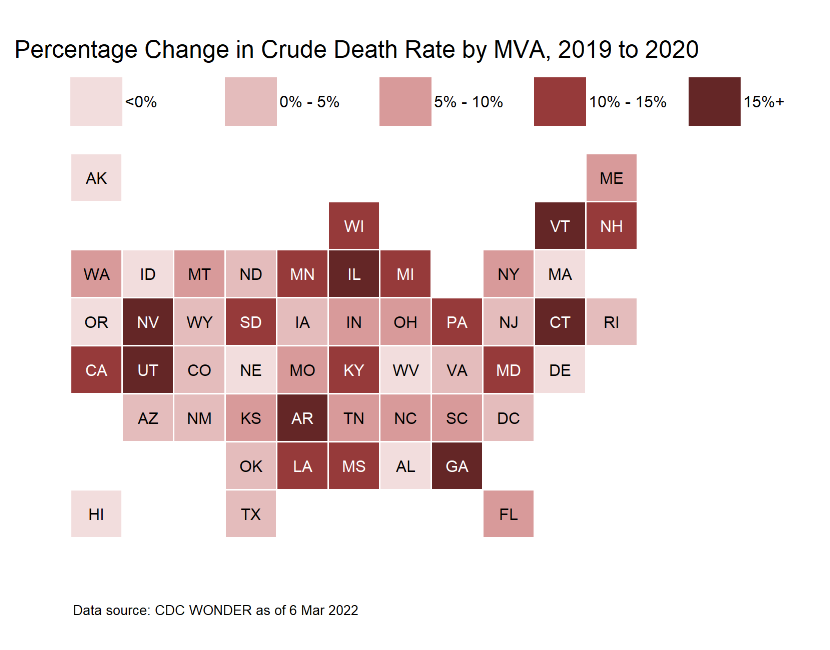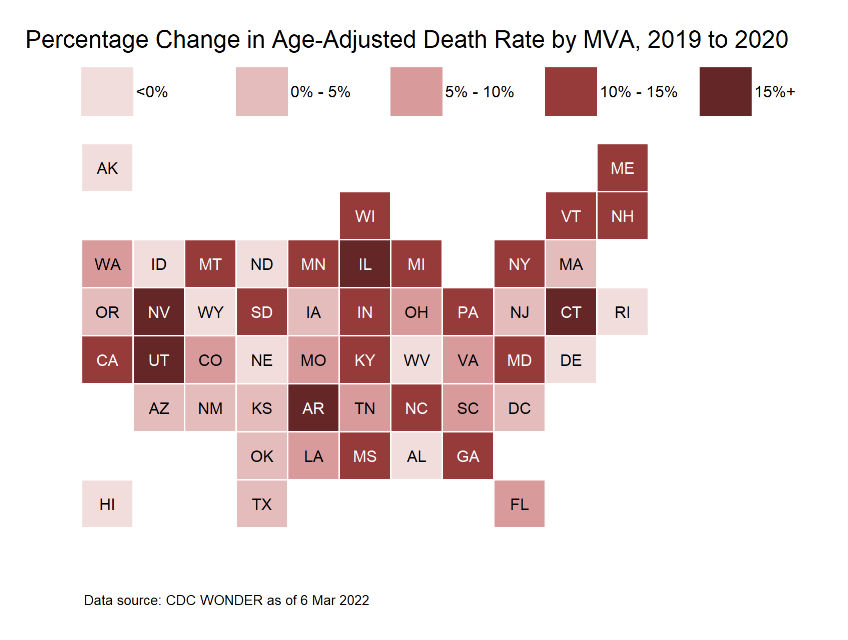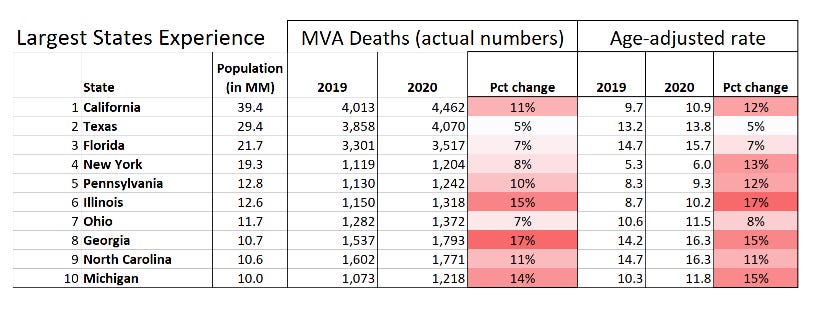Motor Vehicle Accident Deaths, Part 3: Geographical Differences, 2019 vs 2020
Yes, a geographic pattern to rates; no geographic pattern to changes
This closes out the series on motor vehicle accident death changes between 2019 and 2020.
We somewhat expect the accident death rates to differ by state partly due to different driving conditions… and we all know “those people” in “those states” just drive like maniacs (fill in the blank).
Setting the stage: relatively large increases in 2020 and continuing to be bad in 2021
As a reminder, age-adjusted death rates for motor vehicle accident deaths increased 9% between 2019 and 2020, which is actually the highest single-year increase for this cause of death going back to 1968.
That said, motor vehicle accident deaths have a variety of drivers (cough), which include how much people are driving, road safety, traffic law enforcement, and other things, which makes it more complicated than some other causes of death.
So while the 9% increase isn’t that much of a headline-grabber compared to the 30% increase for homicides, it is still significant.
Especially in light of how significant MVAs (motor vehicle accidents) are for younger people as a cause of death — 15% of deaths for those age 10-14 in 2020, over 20% of the deaths for those age 15-19, and 18% of deaths for those age 20-24.
Baseline MVA death rates in 2019 — crude rate and age-adjusted rate
First, let us look at tile grid maps of the death rates for homicide by state in 2019.
The crude rate (just number of MVA deaths divided by total population):
The age-adjusted rate (weighted average to a standardized age distribution):
They’re not too different in their distribution. I’m using different scales for the two types of rates, because there is a difference in the distributions due to the effects of age differences. I will be using the same scale for 2020 as 2019 for the same kinds of rates, though.
Some observations:
Yes, Mississippi and Alabama are pretty bad. They do tend to shake out at the bottom on many metrics for the U.S. (for things like literacy and poverty, too).
I will note that the northeast as a region has low MVA death rates, and there is also a Western patch of low MVA deaths. Not sure the explanation for the Western low rates, other than possibly a lot of empty space. If there’s nothing to hit, it’s tough to die. In the northeast, it’s easier to explain: less dependence on motor vehicles.
As a personal example, I managed to not drive much from 1996 when I moved to NYC up until 2011, when I got a job in Hartford, CT, at which point I went to driving about 30K miles per year. My risk profile for MVA death changed drastically then.
In any case, many of us in the northeast ride the train, and it’s a bit difficult to die in a car accident yourself when you’re riding Metro-North for your commute.
Given the remaining pattern I see, I’m really very suspicious that a lot of what I’m seeing is simply drunk driving propensities. It could still be related to low-density living and people needing to drive long distances commonly, and especially having long, flat, boring drives. But again, I’m thinking drunk driving may be the best explanation for the differences between states in pre-pandemic times.
2020 distributions for MVA death rates
Yes, I’m using the same color scale as with 2019 comparable rates so we can see how it shifted.
Crude rate:
Age-adjusted rate:
Observations:
We can see with the crude rate that many states in the north are a little bit darker, but just looking at the tile grid map it is difficult to tell how significant the changes are. (Hold your horses)
For age-adjusted death rates, with this scale, I really can’t tell the difference well.
Hey, the visualizations don’t always work out. Not at first glance, at any rate.
Percentage change from 2019 to 2020
This is where it goes crazy. Let’s plot how the death rates have changed from 2019 to 2020.
For crude rate:
For age-adjusted rate:
This is the “beauty” of real-life data — where there is a nice geographical clustering of the death rates themselves, when we start looking at percentage changes, the structure falls apart.
Some of the high-rate states saw their MVA death rates drop in 2020… but some of those states saw the rates go up.
You can see a few of the low-rate states, like Connecticut, saw their MVA death rates go up by a lot. (Indeed, CT was ranked #1 for increase in MVA death rates)
Some of this rate change volatility comes from what was driving the change — for a state like CT, I’m guessing that lockdowns of various sorts had people who normally commuted by train using their cars instead to move around. Also, when you’ve got a really low death rate to begin with, it doesn’t take a lot more deaths to bump up your rates.
The places that had rates that were already high… and then the MVA death rates went even higher? I can’t tell you. That sounds really bad to me.
Table of changes for largest states
To break away from graphs for a moment, let’s look at a table.
The nationwide statistics are going to be most influenced by the most populous states, and in getting at the largest states, we can better see the dynamics of how MVA deaths may have moved.
So let’s focus on the top ten states by population.
Observations:
You can see some of the disparities in the pre-pandemic rates coming from mass transit use, with New York’s MVA death rate being very low. Its increase in MVA death rates is middle-of-the-pack for this table, but remember overall for the country the age-adjusted death rate increased 9%. A 13% increase is substantial.
Texas, which is a very-motor-vehicle-dependent-culture, barely had an increase in MVA deaths. To be sure, they had one of the higher age-adjusted MVA death rates in the list. But other states with similar pre-pandemic rates had much higher increases in MVA death rates. What’s going on?
As with homicides, it may be that there is a law enforcement component to MVA deaths, and the disparate changes in MVA deaths may relate to how different states responded to traffic control in light of the shift to a delivery economy in many locations.
As gas prices have exceeded $4/gallon in many locations in the U.S. (it did for me this past weekend), and may blow past $5/gal depending on how the Russia/Ukraine conflict develops, the MVA death situation may be a problem that fixes itself in the short term.
The worst is yet to come (on the blog)
I want to wrap up these three series on suicides, homicides, and MVA deaths because all three are significant causes of death for teens and young adults in particular, even before the pandemic.
All three also were relatively large contributors to excess mortality for young adults (age 25-44 in specific) for 2020-2021.
But there is one cause I haven’t done this analysis on yet, and I saved the worst for last: drug overdoses.
Hey, maybe it could get your mind off Ukraine. Always look on the bright side, I say.










